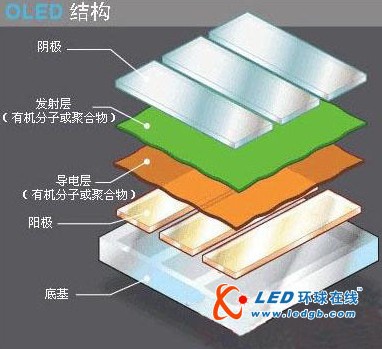An OLED is a solid-state device composed of organic molecular sheets that emit light after application of electricity. OLEDs enable electronic devices to produce brighter, sharper images that consume less power than traditional light-emitting diodes (LEDs) and are smaller than today's liquid crystal displays (LCDs).
In this article, you will learn about the workings of OLED technology, what types of OLEDs, the advantages and disadvantages of OLEDs compared to other luminescent technologies, and some of the problems that OLEDs need to overcome.
Similar to LEDs, OLEDs are solid-state semiconductor devices that are 100-500 nanometers thick and 200 times thinner than hair. The OLED consists of two or three layers of organic material; in accordance with the latest OLED design, the third layer assists in the transfer of electrons from the cathode to the emissive layer. This paper mainly deals with the two-layer design model.
First, the structure of OLED
OLED consists of the following parts:

OLED structure
Base layer (transparent plastic, glass, metal foil) - the base layer is used to support the entire OLED.
Anode (transparent) - The anode eliminates electrons (increasing electron "holes") as current flows through the device.
Organic layer - The organic layer is composed of an organic molecule or an organic polymer.
Conductive layer - This layer is composed of organic plastic molecules that transport "holes" from the anode. Polyaniline can be used as the conductive polymer of the OLED.
Emissive layer - This layer consists of organic plastic molecules (different from the conductive layer) that transport electrons from the cathode; the luminescence process takes place at this layer. Polyfluorene can be used as the emissive layer polymer.
The cathode (which may be transparent or opaque, depending on the type of OLED) - the cathode will inject electrons into the circuit when current is flowing through the device.
Second, the manufacture of OLED
The most important part of the OLED production process is the application of an organic layer to the substrate. There are three ways to do this:
1. Vacuum deposition or vacuum thermal evaporation (VTE)
The organic molecules located in the vacuum chamber are slightly heated (evaporated) and then the molecules are condensed in the form of a film on the lower temperature substrate. This method is costly but less efficient.
2. Organic vapor deposition (OVPD)
In a low-pressure hot-wall reaction chamber, the carrier gas transports the evaporated organic molecules to the low-temperature substrate, and then the organic molecules condense into a film. The use of carrier gas can increase efficiency and reduce the cost of OLEDs.
3, inkjet printing
The inkjet technology is used to spray the OLED onto the substrate as if the ink was sprayed onto the paper during printing. Inkjet technology greatly reduces the cost of OLED production, and can print OLEDs onto very large surface areas for large displays such as 80-inch large-screen TVs or electronic signage.

OLED manufacturing